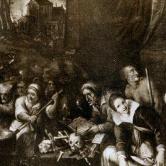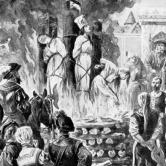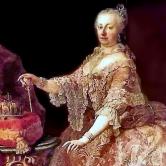Personage > Magda Logomer Herucina
Magda Logomer Herucina was the last woman to be tried as a witch. She was acquitted two and a a half centuries ago, and to this day she is little known in Križevci, her home town. The old manuscripts containing some information about her were burnt after World War Two, at the time when the old charters, and acts, were recycled. She might have lived in the Upper Town, since surnames Lugomer (which is similar to Logomer) and Heruc remain common in this part of town to this today. Empress Maria Theresa acquitted Magda when she was accused of witchcraft, and put her under her protection. Thus, one can say Magda was not so popular in the town. Still, she became a part of the history, she was at the Empress's Court, and not many people can boast of accomplishing that.The accused "witch", Magda Logomer, was put on trial based on accusations of Eva Oblačić and other equally "legible" witnesses, who, when "confronted" by Magda, claimed that she had been "creating" people by using special herbs and potions out of "a feathery mouse", that she had been involved in strange "rituals", trying to "poison" people, or even "murder" them, causing "miscarriage", or "premature birth", and consorting with the"devil".
Eva Oblačić, Magda's neighbour, accused Magda of poisoning her. Magda did practice herbalism and natural healing, but Eva claimed that Magda had been bothering her while she had been laid in bed with fever, flying around her head turned into a fly. She was put on trial, and there were lots of people confirming they had witnessed to Magda's "evil doings". Magda's advocate reminded the Magistrate Court in Križevci that the Empress, Maria Theresa, hadn't been informed about the trial, but that didn't help. Subjected to a cruel torture, Magda came clean, admitting she had been consorting with the devil, and some "diabolical marks" were found on her body. Magda was convicted and sentenced to death on April 22, 1758.The letter Maria Theresa wrote on June 9, 1758, greatly affected the witch persecution in north Croatia. Although there are some records of the witch persecution being continued after 1758, from then on it became more difficult to ask permission from "Her Royal Highness " to put a woman on trial for witchcraft.
As soon as she inherited the throne, the Empress gave specific orders that she was to be informed of each witch trial, so The Magistrate Court had the obligation to inform the Empress of the convictions, and she was the one who approved or prevented the execution. The empress wished to meet an alleged witch in person, and the opportunity soon came. On June 9, 1758 she was informed that a woman named Magda Logomer had been convicted of witchcraft. She ordered count Franjo Nadaždi, the Banus of the Kingdom of Dalmatia, Croatia and Slavonia, to bring Magda to Vienna, to her court.
Magda was sent to a Medical Clinic where she was examined by Mr De Haen, a professor at the Medical Faculty, and Mr Van Swieten, the main court expert for determining sorcery and witchcraft. Mr De Haen asked her many questions with the help of a Croat who was translating the conversation, and found out some details that were not mentioned in the letter the Empress had received. Van Swieten felt sorry for poor Magda, since she had lots of wounds resulting from the torture she underwent in Križevci. He was sincerely appalled by such a barbaric act, and informed the Empress about his examination, accusing the Magistrate Court in Križevci of superstition. Van Swieten did believe in sorcery, but not in the alleged witchcraft, and witches flying on brooms, and arousing storms. Thus, he concluded Magda had been wrongly accused, and tortured, of which he informed the Empress. Maria Theresa wrote a letter to the Banus of Croatia on November 23, 1758, ordering that Magda Logomer Herucina was to be acquitted, and sent back to Križevci.
That's where the story of Magda ends. There are no more records of her in the charts, or documents that are kept in Hungarian or Austrian State Archives. What was the rest of her life like? Did she practise herbalism later on? She must have, since she had to afford dignified living. Still, the Empress' letter couldn't have changed local people's opinion about her, and they must have always wondered if she was a real witch or not.




